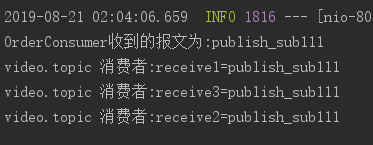1.安装 ActiveMQ
这里以 ActiveMQ 5.15.3 版本为例,下载地址:http://activemq.apache.org/activemq-5153-release.html
官网提供的快速开始案例:http://activemq.apache.org/getting-started.html
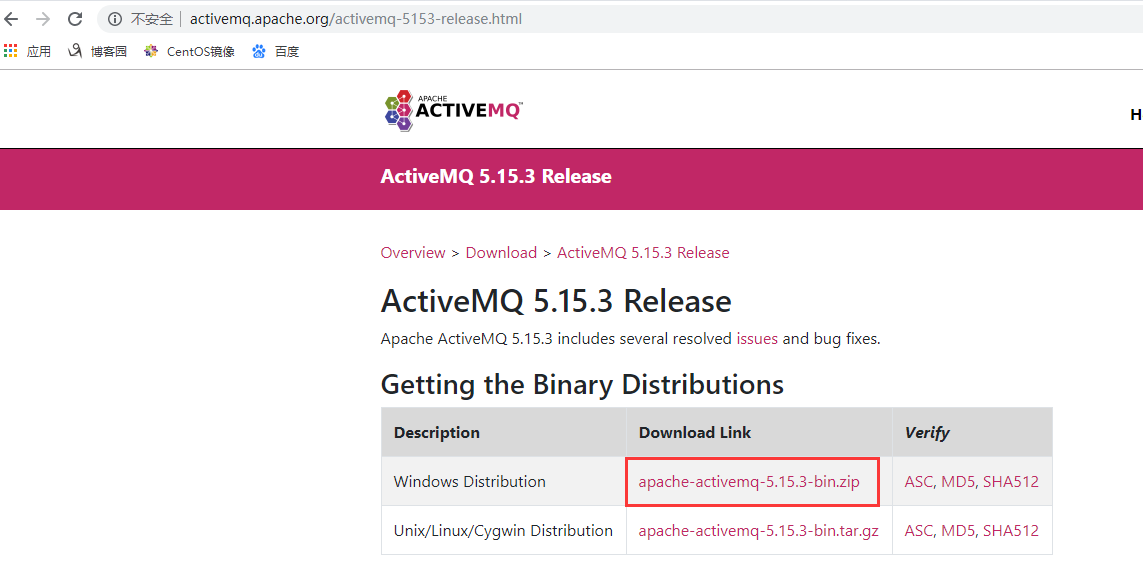
下载完以后,解压到用户自定义的目录下
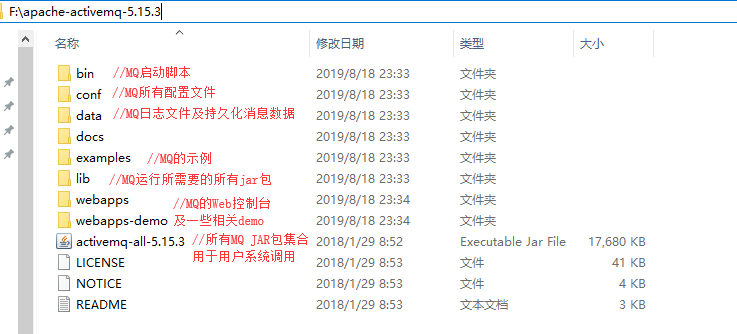
如果我们是 32 位的机器,就双击 win32 目录下的 activemq.bat,如果是 64 位机器,则双击 win64 目录下的 activemq.bat

启动后访问路径 http://127.0.0.1:8161/,用户名和密码默认都是 admin
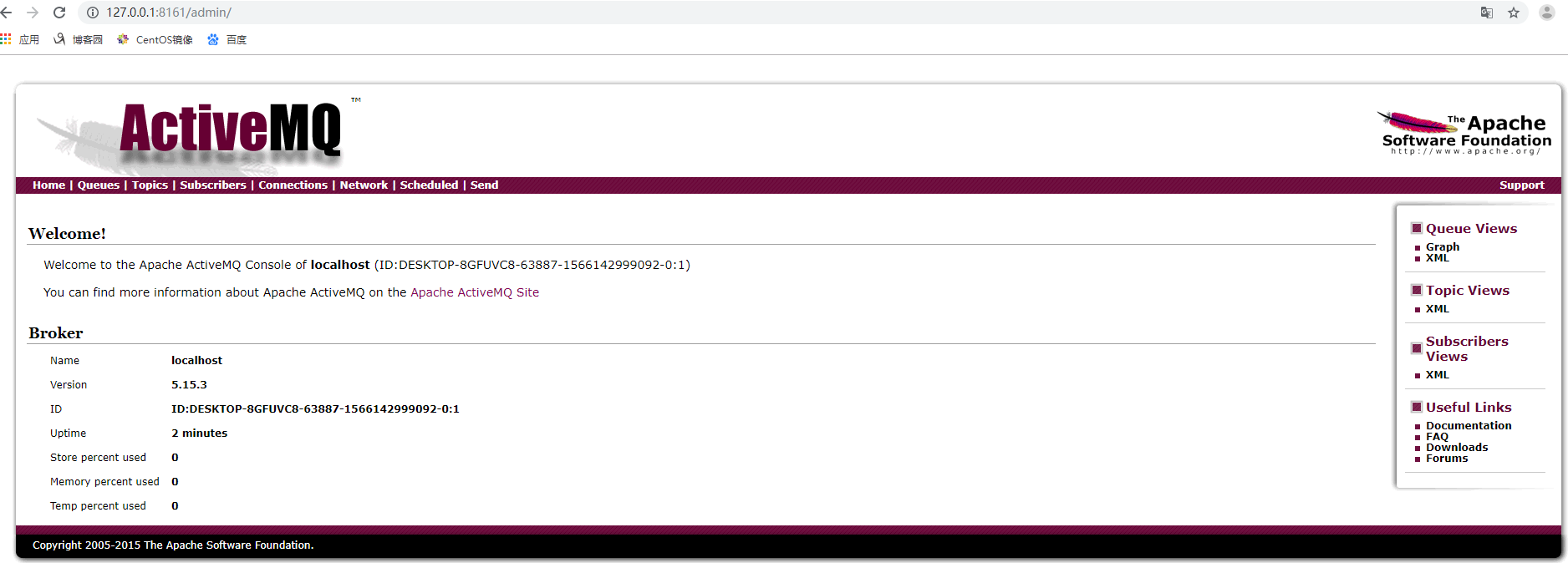
新增消息队列

2. Spring Boot 2.X 整合 ActiveMQ 之点对点消息
步骤1:加入依赖
<!-- 整合消息队列ActiveMQ --> <dependency> <groupId>org.springframework.boot</groupId> <artifactId>spring-boot-starter-activemq</artifactId> </dependency> <!-- 如果配置线程池则加入 --> <dependency> <groupId>org.apache.activemq</groupId> <artifactId>activemq-pool</artifactId> </dependency> <!-- 如果JmsMessagingTemplate无法自动注入,就引入以下依赖 --> <dependency> <groupId>org.messaginghub</groupId> <artifactId>pooled-jms</artifactId> <version>1.0.3</version> </dependency>
步骤2:application.properties 配置文件配置
#整合jms测试,安装在别的机器,防火墙和端口号记得开放
spring.activemq.broker-url=tcp://127.0.0.1:61616
#集群配置
#spring.activemq.broker-url=failover:(tcp://localhost:61616,tcp://localhost:61617)
spring.activemq.user=admin
spring.activemq.password=admin
#下列配置要增加依赖
spring.activemq.pool.enabled=true
spring.activemq.pool.max-connections=100
步骤3:Spring Boot 启动类增加注解 @EnableJms,开启支持 JMS
@SpringBootApplication @EnableJms public class XdclassApplication { @Bean public Queue queue(){ return new ActiveMQQueue("common.queue"); } public static void main(String[] args) { SpringApplication.run(XdclassApplication.class, args); } }
步骤4:建立 service 接口及其实现类
package com.example.demo.service; import javax.jms.Destination; /** * 功能描述:消息生产 */ public interface ProducerService { /** * 功能描述:指定消息队列,还有消息 * @param destination * @param message */ public void sendMessage(Destination destination, final String message); /** * 功能描述:使用默认消息队列, 发送消息 * @param message */ public void sendMessage(final String message); }
实现类
package com.example.demo.service.impl; import javax.jms.Destination; import javax.jms.Queue; import javax.jms.Topic; import com.example.demo.service.ProducerService; import org.springframework.beans.factory.annotation.Autowired; import org.springframework.jms.core.JmsMessagingTemplate; import org.springframework.stereotype.Service; /** * 功能描述:消息生产者 */ @Service public class ProducerServiceImpl implements ProducerService{ @Autowired private Queue queue; /** * 用来发送消息到broker的对象 */ @Autowired private JmsMessagingTemplate jmsMessagingTemplate; /** * 发送消息,destination是发送到的队列,message是待发送的消息*/ @Override public void sendMessage(Destination destination, String message) { jmsMessagingTemplate.convertAndSend(destination, message); } /** * 发送消息,destination是发送到的队列,message是待发送的消息*/ @Override public void sendMessage(final String message) { jmsMessagingTemplate.convertAndSend(queue, message); } }
步骤5:新建 controller 用来测试
package com.example.demo.controller; import javax.jms.Destination; import com.example.demo.domain.JsonData; import com.example.demo.service.ProducerService; import org.apache.activemq.command.ActiveMQQueue; import org.springframework.beans.factory.annotation.Autowired; import org.springframework.web.bind.annotation.GetMapping; import org.springframework.web.bind.annotation.RequestMapping; import org.springframework.web.bind.annotation.RestController; /** * 功能描述:模拟微信支付回调 */ @RestController @RequestMapping("/api/v1") public class OrderController { @Autowired private ProducerService producerService; /** * 功能描述:微信支付回调接口 * @param msg 支付信息 * @return */ @GetMapping("order") public Object order(String msg){ Destination destination = new ActiveMQQueue("order.queue"); producerService.sendMessage(destination, msg); return JsonData.buildSuccess(); } @GetMapping("common") public Object common(String msg){ producerService.sendMessage(msg); return JsonData.buildSuccess(); } }
模拟请求:http://localhost:8080/api/v1/order?msg=123
以上步骤完成了向队列里发送消息的代码,但只有生产消息的代码,还不够,还需要消费消息的代码
步骤6:新建消费者:实时监听对应的队列
package com.example.demo.jms; import org.springframework.jms.annotation.JmsListener; import org.springframework.stereotype.Component; @Component public class OrderConsumer { @JmsListener(destination="order.queue")//实时监听消息队列,这里监听了名为:order.queue 的队列 public void receiveQueue(String text){ System.out.println("OrderConsumer收到的报文为:"+text); } }

项目结构如下图所示:
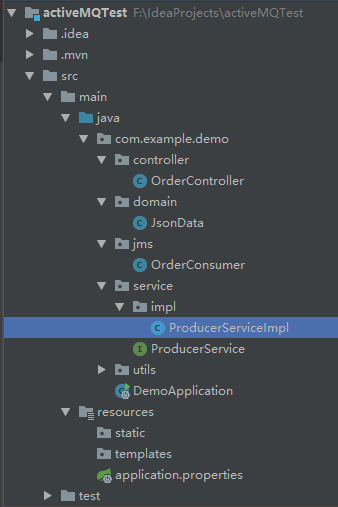
注意:
1)消费者一般是单独的项目,这里写在一起方便测试
2)之所以是点对点消息,是因为只能被一个消费者捕获到,定义多个消费者是没有用的,比如,再定义一个消费者
public class OrderConsumer { @JmsListener(destination="order.queue") public void receiveQueue(String text){ System.out.println("OrderConsumer收到的报文为:"+text); } @JmsListener(destination="order.queue") public void receiveQueue2(String text){ System.out.println("OrderConsumer222收到的报文为:"+text); } }
最后的输出如下图所示,所以点对点消息无法被多个消费者消费

3. Spring Boot 2.X 整合 ActiveMQ 之发布订阅模式
如果想被多个消费者消费,需要对上面的项目进行改造
步驟1:pom 文件还是和上面的一样
步驟2:首先需要支持发布订阅,在配置文件中进行配置(默认只支持点对点)
#整合jms测试,安装在别的机器,防火墙和端口号记得开放
spring.activemq.broker-url=tcp://127.0.0.1:61616
#集群配置
#spring.activemq.broker-url=failover:(tcp://localhost:61616,tcp://localhost:61617)
spring.activemq.user=admin
spring.activemq.password=admin
#下列配置要增加依赖
spring.activemq.pool.enabled=true
spring.activemq.pool.max-connections=100
#default point to point
spring.jms.pub-sub-domain=true
步骤3:Spring Boot 启动类增加注解 @EnableJms,开启支持 JMS,和上面的项目其实是一样的
@SpringBootApplication @EnableJms public class XdclassApplication { @Bean public Topic topic(){ return new ActiveMQTopic("video.topic"); }
public static void main(String[] args) { SpringApplication.run(XdclassApplication.class, args); } }
步骤4:建立 service 接口及其实现类
package com.example.demo.service; import javax.jms.Destination; public interface ProducerService { public void publish(String msg); }
实现类
@Service public class ProducerServiceImpl implements ProducerService{ @Autowired private JmsMessagingTemplate jmsMessagingTemplate; @Autowired private Topic topic; @Override public void publish(String msg) { this.jmsMessagingTemplate.convertAndSend(this.topic, msg); } }
步骤5:新建 controller 用来测试
@RestController @RequestMapping("/api/v1") public class OrderController { @Autowired private ProducerService producerService; @GetMapping("topic") public Object publish(String msg){ producerService.publish(msg); return JsonData.buildSuccess(); } }
模拟请求:http://localhost:8080/api/v1/topic?msg=publish_sub
以上步骤完成了向主题(Topic)里发送消息的代码,但只有发布消息的代码,还不够,还需要订阅消息的代码
步骤6:新建订阅者:实时监听对应的Topic
@Component public class TopicSub { @JmsListener(destination="video.topic") public void receive1(String text){ System.out.println("video.topic 消费者:receive1="+text); } @JmsListener(destination="video.topic" ) public void receive2(String text){ System.out.println("video.topic 消费者:receive2="+text); } @JmsListener(destination="video.topic" ) public void receive3(String text){ System.out.println("video.topic 消费者:receive3="+text); } }
当发布者发布消息时,订阅者就能实时收到消息,效果如下图所示:

注意:以上配置不支持点对点(生产者依然可以生产消息,但是消费者无法消费)
4. 为了同时支持点对点和发布订阅模式,需要做以下修改
步骤1:在配置文件里面,注释掉 #spring.jms.pub-sub-domain=true
步骤2:@JmsListener 如果不指定独立的 containerFactory 的话是只能消费 queue 消息,需要给 topic 定义独立的 JmsListenerContainer
@SpringBootApplication @EnableJms public class DemoApplication { @Bean public Queue queue(){ return new ActiveMQQueue("common.queue"); } @Bean public Topic topic(){ return new ActiveMQTopic("video.topic"); } @Bean public JmsListenerContainerFactory<?> jmsListenerContainerTopic(ConnectionFactory activeMQConnectionFactory) { DefaultJmsListenerContainerFactory bean = new DefaultJmsListenerContainerFactory(); bean.setPubSubDomain(true); bean.setConnectionFactory(activeMQConnectionFactory); return bean; } public static void main(String[] args) { SpringApplication.run(DemoApplication.class, args); } }
步骤3:修改订阅者 container:containerFactory="jmsListenerContainerTopic"
package com.example.demo.jms; import org.springframework.jms.annotation.JmsListener; import org.springframework.stereotype.Component; @Component public class TopicSub { @JmsListener(destination="video.topic", containerFactory="jmsListenerContainerTopic") public void receive1(String text){ System.out.println("video.topic 消费者:receive1="+text); } @JmsListener(destination="video.topic" , containerFactory="jmsListenerContainerTopic") public void receive2(String text){ System.out.println("video.topic 消费者:receive2="+text); } @JmsListener(destination="video.topic" , containerFactory="jmsListenerContainerTopic") public void receive3(String text){ System.out.println("video.topic 消费者:receive3="+text); } }
效果如下图所示,同时支持点对点和发布订阅模式
